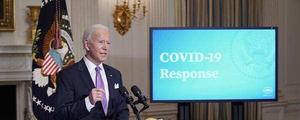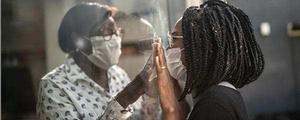Story Highlights
- 38% of fully vaccinated Americans making effort to isolate
- Fully vaccinated adults most optimistic about COVID-19 situation
- Visits to most public places similar regardless of vaccination status
- Vaccinated American continue to report wearing masks in public settings
WASHINGTON, D.C. -- A Gallup analysis finds U.S. adults who have been fully vaccinated against COVID-19 are less likely than those partially or not yet vaccinated to be practicing strict social distancing. These results come as an increasing number of U.S. adults are getting vaccinated and the Centers for Disease Control this week issues new guidance on safe behaviors for vaccine recipients.
Whereas 38% of adults who have been fully vaccinated say they are completely or mostly isolating themselves from people outside their household, majorities of those who have been partially vaccinated (51%) or not yet vaccinated but plan to be (57%) say the same. Americans who indicate they will not get vaccinated are least likely to be completely or mostly isolating themselves, at 28%.
| Fully vaccinated | Partially vaccinated | Plan to get vaccinated | Do not plan to get vaccinated | ||||||||||||||||||||||||||||||||||||||||||||||||||||||||||||||||||||||||||||||||||||||||||||||||
|---|---|---|---|---|---|---|---|---|---|---|---|---|---|---|---|---|---|---|---|---|---|---|---|---|---|---|---|---|---|---|---|---|---|---|---|---|---|---|---|---|---|---|---|---|---|---|---|---|---|---|---|---|---|---|---|---|---|---|---|---|---|---|---|---|---|---|---|---|---|---|---|---|---|---|---|---|---|---|---|---|---|---|---|---|---|---|---|---|---|---|---|---|---|---|---|---|---|---|---|
| % | % | % | % | ||||||||||||||||||||||||||||||||||||||||||||||||||||||||||||||||||||||||||||||||||||||||||||||||
| Completely isolated | 10 | 16 | 20 | 11 | |||||||||||||||||||||||||||||||||||||||||||||||||||||||||||||||||||||||||||||||||||||||||||||||
| Mostly isolated | 28 | 35 | 37 | 17 | |||||||||||||||||||||||||||||||||||||||||||||||||||||||||||||||||||||||||||||||||||||||||||||||
| Partially isolated | 32 | 26 | 23 | 18 | |||||||||||||||||||||||||||||||||||||||||||||||||||||||||||||||||||||||||||||||||||||||||||||||
| Isolated yourself a little | 16 | 14 | 12 | 15 | |||||||||||||||||||||||||||||||||||||||||||||||||||||||||||||||||||||||||||||||||||||||||||||||
| No attempt to isolate | 14 | 9 | 8 | 39 | |||||||||||||||||||||||||||||||||||||||||||||||||||||||||||||||||||||||||||||||||||||||||||||||
| NET: Completely/Mostly | 38 | 51 | 57 | 28 | |||||||||||||||||||||||||||||||||||||||||||||||||||||||||||||||||||||||||||||||||||||||||||||||
| Gallup Panel | |||||||||||||||||||||||||||||||||||||||||||||||||||||||||||||||||||||||||||||||||||||||||||||||||||
These results are based on combined January and February data from Gallup's COVID-19 tracking survey, encompassing interviews with 7,806 U.S. adults who are members of Gallup's probability-based panel. In the January interviewing, 2% reported being fully vaccinated and 7% partially vaccinated, and in February, the figures were 7% and 9%, respectively.
Polling was completed before the Food and Drug Administration approved emergency use of the Johnson & Johnson single-dose vaccine. Thus, all respondents who had been vaccinated received the Pfizer or Moderna vaccines which require two doses.
Twenty-nine percent in both the January and February interviewing say they do not plan to get vaccinated at all.
Gallup has recently found little change in the percentage of all U.S. adults who are completely or mostly isolating themselves from others when compared with measures taken during the November and December surge in new infections. At 47%, strict social distancing behavior remains higher than before that surge. Given the relationship between vaccination status and social distancing efforts, the figure should come down as more Americans get the required doses of the vaccine in the coming months.
Vaccine Recipients Less Likely to Avoid Public Places, Small Gatherings
In addition to making less of an effort to isolate themselves from others, vaccine recipients are less likely to report avoiding public places and small gatherings of people. However, those fully vaccinated are no less likely than their peers to avoid travel and large crowds. Importantly, vaccine recipients are just as likely as non-recipients to say they are wearing facemasks in public, consistent with guidance from the Centers for Disease Control.
Americans who are not planning to get vaccinated are far less likely than all others, including those who are fully vaccinated, to report practicing these COVID-19 mitigation practices.
| Fully vaccinated | Partially vaccinated | Plan to get vaccinated | Do not plan to get vaccinated | ||||||||||||||||||||||||||||||||||||||||||||||||||||||||||||||||||||||||||||||||||||||||||||||||
|---|---|---|---|---|---|---|---|---|---|---|---|---|---|---|---|---|---|---|---|---|---|---|---|---|---|---|---|---|---|---|---|---|---|---|---|---|---|---|---|---|---|---|---|---|---|---|---|---|---|---|---|---|---|---|---|---|---|---|---|---|---|---|---|---|---|---|---|---|---|---|---|---|---|---|---|---|---|---|---|---|---|---|---|---|---|---|---|---|---|---|---|---|---|---|---|---|---|---|---|
| % | % | % | % | ||||||||||||||||||||||||||||||||||||||||||||||||||||||||||||||||||||||||||||||||||||||||||||||||
| Avoided going to public places | 60 | 73 | 69 | 29 | |||||||||||||||||||||||||||||||||||||||||||||||||||||||||||||||||||||||||||||||||||||||||||||||
| Avoided small gatherings of people | 59 | 69 | 67 | 26 | |||||||||||||||||||||||||||||||||||||||||||||||||||||||||||||||||||||||||||||||||||||||||||||||
| Avoided going to events with large crowds | 82 | 83 | 84 | 40 | |||||||||||||||||||||||||||||||||||||||||||||||||||||||||||||||||||||||||||||||||||||||||||||||
| Avoided traveling | 77 | 78 | 77 | 38 | |||||||||||||||||||||||||||||||||||||||||||||||||||||||||||||||||||||||||||||||||||||||||||||||
| Worn a mask on your face when outside your home | 97 | 98 | 97 | 71 | |||||||||||||||||||||||||||||||||||||||||||||||||||||||||||||||||||||||||||||||||||||||||||||||
| Figures are the percentage who report having done the activity in the past seven days | |||||||||||||||||||||||||||||||||||||||||||||||||||||||||||||||||||||||||||||||||||||||||||||||||||
| Gallup Panel | |||||||||||||||||||||||||||||||||||||||||||||||||||||||||||||||||||||||||||||||||||||||||||||||||||
Fully Vaccinated Americans Not Showing a Surge in Most Out-of-Home Activities
A separate question, asking about specific places respondents have visited in the past 24 hours, finds little difference by vaccination status. Those who have and have not been vaccinated are about as likely to say they visited stores, restaurants and other people's houses in the past 24 hours.
One exception concerns workplaces, although the distinction, in this case, is between those who have been fully or partially vaccinated versus those who have not yet been vaccinated. Fifty-eight percent of employed adults who have received at least one dose of COVID-19 vaccine report visiting their workplace in the past 24 hours, compared with 43% of workers who have not yet been vaccinated. To some degree, this difference could reflect that essential workers are more likely to have been prioritized for vaccination in addition to feeling safer going into the workplace because they have been vaccinated.
Workers who do not plan to get vaccinated are more likely than others to have visited their workplace in the past 24 hours, with 68% reporting doing so.
COVID-19 Concern Diminished, but Not Eliminated Among the Vaccinated Population
As would be expected, getting vaccinated is linked with significantly lower worry about getting COVID-19. Still, those who have been fully vaccinated retain some level of concern, with 35% very or somewhat worried about getting the disease. Meanwhile, at least six in 10 who have been partially vaccinated or who have not yet been vaccinated are worried about getting COVID-19.
Those who do not plan to get vaccinated are much less likely to be worried about getting COVID-19, with 19% expressing worry, which could partly explain their unwillingness to get immunized.
| Fully vaccinated | Partially vaccinated | Plan to get vaccinated | Do not plan to get vaccinated | ||||||||||||||||||||||||||||||||||||||||||||||||||||||||||||||||||||||||||||||||||||||||||||||||
|---|---|---|---|---|---|---|---|---|---|---|---|---|---|---|---|---|---|---|---|---|---|---|---|---|---|---|---|---|---|---|---|---|---|---|---|---|---|---|---|---|---|---|---|---|---|---|---|---|---|---|---|---|---|---|---|---|---|---|---|---|---|---|---|---|---|---|---|---|---|---|---|---|---|---|---|---|---|---|---|---|---|---|---|---|---|---|---|---|---|---|---|---|---|---|---|---|---|---|---|
| % | % | % | % | ||||||||||||||||||||||||||||||||||||||||||||||||||||||||||||||||||||||||||||||||||||||||||||||||
| Very worried | 6 | 11 | 16 | 4 | |||||||||||||||||||||||||||||||||||||||||||||||||||||||||||||||||||||||||||||||||||||||||||||||
| Somewhat worried | 29 | 49 | 50 | 15 | |||||||||||||||||||||||||||||||||||||||||||||||||||||||||||||||||||||||||||||||||||||||||||||||
| Not too worried | 43 | 34 | 28 | 38 | |||||||||||||||||||||||||||||||||||||||||||||||||||||||||||||||||||||||||||||||||||||||||||||||
| Not worried at all | 22 | 6 | 6 | 43 | |||||||||||||||||||||||||||||||||||||||||||||||||||||||||||||||||||||||||||||||||||||||||||||||
| Gallup Panel | |||||||||||||||||||||||||||||||||||||||||||||||||||||||||||||||||||||||||||||||||||||||||||||||||||
When those who say they do not intend to get a COVID-19 vaccine are asked about reasons why they will not do so, 10% say they already had the coronavirus, which could partly explain their lower worry about getting the disease. The most common reasons they give for not wanting to get vaccinated are safety concerns (22%), a belief they wouldn't get seriously ill from the virus (19%), the rushed timeline for developing the vaccines (16%) and distrust of vaccines, generally (15%).
Overall, 49% of Americans are very or somewhat concerned about getting COVID-19, similar to the 51% who expressed worry in the January survey, but down from 58% when infections began to surge in November.
Vaccine Recipients More Optimistic About COVID-19 Situation
Overall, 44% of Americans say they are satisfied with the vaccination rollout in the U.S., an increase from 34% in January. Americans who have been vaccinated, either fully or partially, are more likely than those who have not yet been vaccinated to report being satisfied with the rollout.
Vaccine recipients are also more likely than non-recipients to believe the COVID-19 situation is getting better rather than worse. Roughly six in 10 vaccine recipients view the situation as improving, compared with less than half of those who haven't gotten vaccinated.
| Fully vaccinated | Partially vaccinated | Plan to get vaccinated | Do not plan to get vaccinated | |||||||||||||||||||||||||||||||||||||||||||||||||||||||||||||||||||||||||||||||||||||||||||||||||
|---|---|---|---|---|---|---|---|---|---|---|---|---|---|---|---|---|---|---|---|---|---|---|---|---|---|---|---|---|---|---|---|---|---|---|---|---|---|---|---|---|---|---|---|---|---|---|---|---|---|---|---|---|---|---|---|---|---|---|---|---|---|---|---|---|---|---|---|---|---|---|---|---|---|---|---|---|---|---|---|---|---|---|---|---|---|---|---|---|---|---|---|---|---|---|---|---|---|---|---|---|
| % | % | % | % | |||||||||||||||||||||||||||||||||||||||||||||||||||||||||||||||||||||||||||||||||||||||||||||||||
| Satisfied with U.S. vaccination process | ||||||||||||||||||||||||||||||||||||||||||||||||||||||||||||||||||||||||||||||||||||||||||||||||||||
| Very satisfied/Satisfied | 50 | 46 | 34 | 45 | ||||||||||||||||||||||||||||||||||||||||||||||||||||||||||||||||||||||||||||||||||||||||||||||||
| Very dissatisfied/Dissatisfied | 49 | 54 | 67 | 55 | ||||||||||||||||||||||||||||||||||||||||||||||||||||||||||||||||||||||||||||||||||||||||||||||||
| Impression of U.S. COVID-19 situation | ||||||||||||||||||||||||||||||||||||||||||||||||||||||||||||||||||||||||||||||||||||||||||||||||||||
| Getting a lot/a little better | 62 | 58 | 47 | 38 | ||||||||||||||||||||||||||||||||||||||||||||||||||||||||||||||||||||||||||||||||||||||||||||||||
| Staying the same | 22 | 18 | 22 | 40 | ||||||||||||||||||||||||||||||||||||||||||||||||||||||||||||||||||||||||||||||||||||||||||||||||
| Getting a lot/a little worse | 15 | 25 | 30 | 22 | ||||||||||||||||||||||||||||||||||||||||||||||||||||||||||||||||||||||||||||||||||||||||||||||||
| Gallup Panel | ||||||||||||||||||||||||||||||||||||||||||||||||||||||||||||||||||||||||||||||||||||||||||||||||||||
Americans' vaccination status is unrelated to their perceptions of how long COVID-19 disruptions will continue in the U.S. About half of Americans, regardless of vaccination status, expect disruptions to continue into the second half of 2021 or beyond.
Bottom Line
Public health experts, political leaders and ordinary citizens saw COVID-19 vaccines as key to getting U.S. society back to "normal" as quickly as possible. The rapid timeline for developing vaccines -- with three now being approved for use in the U.S. -- and recent improvements in vaccine supply and administration are helping to put the goal of getting back to normal closer each day.
Americans who have been vaccinated feel freer than those not yet fully vaccinated to relax their social distancing behaviors. But as of now, self-reports of outside-the-home activities -- apart from visiting the workplace -- appear not much different from those who have not been fully vaccinated, perhaps because such activities would still mostly be done with people who have not yet been fully vaccinated. As a greater proportion of the public gets fully vaccinated, reports of visits to restaurants, stores and other people's homes may increase.
Because those who have been vaccinated may still be capable of spreading the disease to others, it is important to note that Americans who have gotten vaccinated still almost universally say they wear facemasks when out in public. To some degree, this could also be related to uncertainty about new variants of the coronavirus and how well the vaccines protect against those.
Last week the Biden administration predicted that there would be enough supply to vaccinate everyone in the U.S. who wanted to do so by the end of May. With a steady 71% of Americans saying they have been vaccinated or wish to do so, the question is whether that proportion would be high enough to establish herd immunity from the disease in the U.S., or if efforts need to be made to encourage the 29% not planning to get the vaccine to do so.
Learn more about how the Gallup Panel works.




